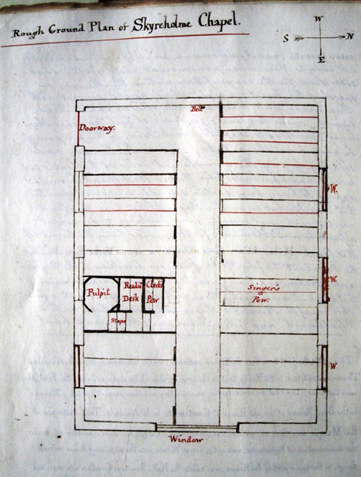Skyreholme is in the ancient parish of Burnsall which originally covered a large area of upper Wharfedale from Skyreholme in the south to Kilnsey in the north and included Bordley, Conistone, Cracoe, Rylstone, Thorpe, Burnsall, Hartlington and Appletreewick. As many of these places were far from the Parish Church of St Wilfrid in Burnsall, Chapels of Ease were built at Coniston, Rylstone and Bordley. St Mary?s at Coniston and St Peter?s at Rylstone survive but the chapel at Bordley has long since disappeared.
Skyreholme was one of the last of the outlying communities to acquire a chapel of ease. In the early nineteenth century the hamlet was a thriving community. The population in the 1841 census was 234 men women and children. There were four working farms run by John Calvert, David Darnbrough, John Inman and John Reynard. The main industry was the flourishing cotton and calico mill managed by Thomas Craven which employed the majority of the working population. In addition the lead mining industry was still a source of employment.
The Burnsall church records show that the local people raised ?206-10s-0d to a fund to build a chapel on land at the corner of Hazler Lane and New Road once owned by the Revd Albert Cockshott Bland of Appletreewick, who later became an assistant curate at St Wilfrid?s (1849-1860). The building was completed by 1837.
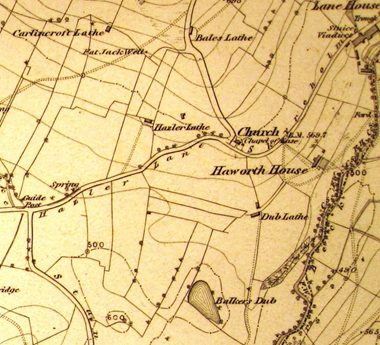 |
| A portion of the 1852 OS map showing the location of Christchurch Chapel of Ease at Skyreholme. |
The Burnsall parish clergy at the time were the Reverend John Baines Graham, M.A., who looked after the Upper Parish (Bordley, Coniston, Kilnsey, Hetton, Rylstone and Cracoe), and the Reverend George Hicks, M.A., who was responsible for the Lower Parish (Skyreholme, Appletreewick, Hartlington, Burnsall and Thorpe sub Montem). In addition to the two rectors, there was an assistant curate. The Reverend Stephen Bland, who it is claimed became the Master of Burnsall Grammar School at the age of sixteen was Curate of St Wilfrid?s from 1812-1850. He lived in Burnsall Rectory.
At that time the parish of Burnsall was in the newly formed diocese of Ripon. It was the Right Reverend Charles Longley, the first Bishop of the Diocese who in 1837 granted a licence to allow divine service to be celebrated in the new chapel at Skyreholme which was named Christchurch.
Christchurch Chapel was built in a simple Gothic revival style with pointed windows.
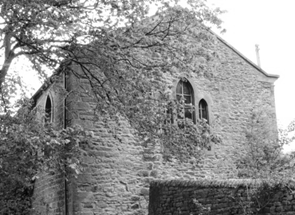 |
| Christchurch Skyreholme on the corner of Hazler Lane and New Road taken from the south east. |
|
||||||||
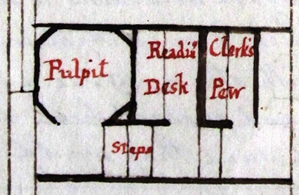 |
This consisted of a lower level for the Parish Clerk from which community announcement would be made. A middle level for the reading Desk from which Gospel would be read. The top level (or pulpit) was used by the Minister from which he preached his sermon.
The prominence of these pulpits was intended to symbolise the proclamation of the word of God as the central part of Christian worship |
| Detail of the plan of three decker pulpit in Christ Church Skyreholme | |
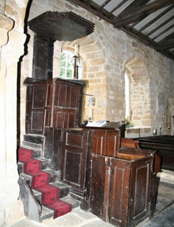 |
A three decker pulpit in All Saints Church, Great Ayton, North Yorkshire. This example was erected in 1759 and appears to be the work of a country joiner or carpenter. The pulpit in Christchurch Skyreholme would have been very similar to this one. |
There is little surviving written information about the worship and activities at Christchurch but a few snippets can be gleaned from the Burnsall Parish Magazine. For example in 1890, Evening Prayer with Sermon was held every Sunday at 2 pm.
From 1867 the Christchurch Chapel had been doubling up as a school. The Revd Augustus George Moore, who was a Curate of Burnsall (1866-1867) had organised a public subscription among parents to start a new school there. This school was opened in 1867 by for about 23 scholars from the Parish of Burnsall.
The chapel continued as a place of worship until about 1897. On 27 January 1897 William George Robert the 4th Earl of Craven granted and conveyed to the Rector of Burnsall and his successors a piece land and buildings in Appletreewick for use as a place of worship. The buildings are thought to have been the birthplace of Sir William Craven (the earl?s Yorkshire ancestor). This building was converted to become the Chapel of St John the Baptist, Appletreewick which is still in use.
The Churchwardens accounts for Skyreholme Chapel at Easter 1897 have survived and show a balance for the year of ?1 11s 5d. Perhaps this was passed on to the new chapel of St John which opened at Appletreewick later that year.
| Burnsall Parish Clergy during the lifetime of Christchurch Skyreholme. | |||
| Rector | Instituted | Patron | |
|---|---|---|---|
| George Hicks, M.A. | 22 Apl. 1797 | Archbishop of York | Resigned |
| William Bury, M.A. | 16 Apl. 1839 | William 2nd Earl of Craven | Died in office 10 Feb., 1875 |
| Charles Henry Carlisle, lit | 13 Jul. 1875 | George Grimstone 3rd Earl of Craven | Resigned Michaelmas 1888 to be Rector of Stanton-by-Bridge, Derbyshire. |
| William James Stavert A.M. | 5 Feb. 1889 | William George Robert , 4th Earl of Craven | Retired 1929. |
| Assistant Curates. | |||
| Name | From | To | Notes |
|---|---|---|---|
| Stephen Bland | 1812 | 1859 | (Master of Burnsall School 1812-49) |
| Albert Cockshott Bland, M.A | 1849 | 1860 | |
| Edward Robert King Cummins, B.A. | 1860 | 1862 | |
| Augustus William George Moore, M.A. | 1866 | 1869 | |
| Charles Berry. | 1860 | 1875 | |
